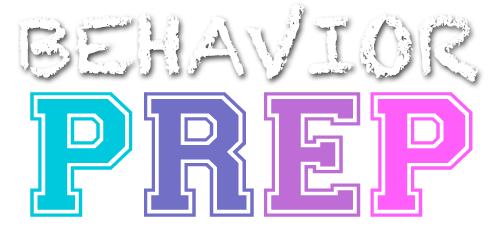G.4 Identify procedures to establish and use conditioned reinforcers (e.g. token economies)
Identifying procedures to establish and use conditioned reinforcers involves creating systems where neutral stimuli (e.g., tokens, points) become reinforcing after being paired with primary or established reinforcers (e.g., food, praise). This process allows these conditioned reinforcers to increase desired behaviors. An example of this is implementing a token economy where tokens are exchanged for preferred rewards.
Establishing and Using Conditioned Reinforcer:
- Identify a Strong Primary Reinforcer
- Definition: A primary reinforcer naturally satisfies a biological or psychological need (e.g., food, water, praise, or toys).
- Action: Identify a reinforcer that the individual already values, such as their favorite snack, playtime with a specific toy, or verbal praise.
- Select a Neutral Stimulus
- Definition: A neutral stimulus initially has no inherent reinforcing value (e.g., tokens, points, stickers).
- Action: Choose an item, token, or symbol that will eventually become the conditioned reinforcer. Common choices include tokens, stickers, or points.
- Pair the Neutral Stimulus with the Primary Reinforcer
- Definition: The neutral stimulus must be consistently presented along with the primary reinforcer, so the individual learns to associate the two.
- Action: Every time the individual earns the primary reinforcer, immediately provide the neutral stimulus along with it. For example, if the primary reinforcer is playtime with a toy, give a token every time the individual earns playtime.
- Definition: The neutral stimulus must be consistently presented along with the primary reinforcer, so the individual learns to associate the two.
- Fade the Primary Reinforcer
- Definition: Over time, the neutral stimulus (now becoming the conditioned reinforcer) should start to acquire reinforcing properties on its own.
- Action: Gradually increase the time between providing the primary reinforcer and the neutral stimulus. For instance, give tokens more frequently than you provide access to the primary reinforcer. This strengthens the value of the tokens themselves.
- Use the Conditioned Reinforcer in a System (e.g., Token Economy)
- Definition: A conditioned reinforcer is now used to maintain or increase desired behavior by allowing individuals to exchange it for the primary reinforcer.
- Action: Create a token economy where individuals earn tokens for engaging in desired behaviors (e.g., completing tasks, following directions). These tokens can be exchanged later for a larger reward (e.g., a toy or special activity).
- Monitor and Adjust the System
- Definition: Ensure the conditioned reinforcer maintains its effectiveness over time by periodically reviewing the system.
- Action: Track the individual’s progress and adjust the system if needed, such as changing the ratio of tokens to rewards or introducing new primary reinforcers to keep the system motivating.
Example: A BCBA works with a child who enjoys playing with a particular toy. To create a token economy, the BCBA introduces a system where the child earns tokens for completing tasks, such as homework. These tokens can be exchanged later for time playing with the toy (the primary reinforcer). Over time, the tokens become conditioned reinforcers because the child associates them with the opportunity to earn the preferred toy. The BCBA monitors and adjusts the system to ensure it effectively motivates the child to complete tasks.
Empiricism
Empiricism emphasizes the importance of objective observation and systematic measurement of behavior. Behavior analysts rely on direct observation and data collection methods to gather information about behavior, which is then analyzed and used to inform decision-making.
Example: A behavior analyst uses direct observation and data collection tools, such as event recording or interval recording, to measure a child’s frequency of engaging in a specific behavior, such as hitting. The data collected empirically provides an objective basis for assessing behavior and evaluating the effectiveness of interventions.
Experimentation
Experimentation is a fundamental aspect of behavior analysis. It involves systematically manipulating variables to determine their effects on behavior. Experimental methods allow behavior analysts to establish functional relationships between environmental events and behavior.
Example: A behavior analyst designs an experiment to investigate the effects of different reinforcement schedules on a target behavior, such as increasing the frequency of a child’s homework completion. By systematically manipulating the reinforcement schedule and measuring behavior, the analyst can determine the most effective schedule for promoting the desired behavior change.
Replication
Replication involves conducting studies or experiments multiple times to verify the reliability and generalizability of findings. Replication is essential in behavior analysis to ensure that observed effects are not due to chance or unique circumstances.
Example: A behavior analyst replicates a study that demonstrated the effectiveness of a particular intervention for reducing self-injurious behavior in individuals with autism. By replicating the study and obtaining similar results, the analyst strengthens the confidence in the intervention’s effectiveness and its applicability to different individuals or settings.
Parsimony
Parsimony, also known as the principle of simplicity, suggests that explanations should be kept as simple as possible while still accounting for the observed behavior. Behavior analysts strive to offer explanations that involve the fewest assumptions necessary to understand and predict behavior.
Example: When explaining a child’s aggressive behavior, a behavior analyst might propose that it is influenced by a lack of social skills and frustration due to communication difficulties, rather than invoking complex or speculative explanations involving internal mental states.
Philosophical Doubt
Philosophical doubt is a critical attitude that encourages behavior analysts to question and examine the validity of existing explanations and assumptions. It involves a healthy skepticism and a commitment to basing conclusions on empirical evidence.
Example: A behavior analyst critically evaluates a widely held belief that a child’s tantrums are solely due to attention-seeking. By applying philosophical doubt, the analyst examines alternative explanations, such as escape from demands or sensory sensitivities, and conducts a thorough functional analysis to determine the true function of the behavior.
These philosophical assumptions provide a solid foundation for the science of behavior analysis. They promote objectivity, systematic observation, experimentation, replication, simplicity, and critical thinking, leading to evidence-based practices and a better understanding of behavior and its environmental determinants.
